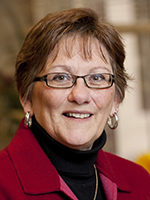
by Lauren Hoffman, September 9, 2019, 60-minute interview (abridged)
Interview with Cynthia Buettner | Professor, Department of Human Sciences | Human Development and Family Science
L: One of your publications mentioned the proximal process. I’m still a little unclear about what that is in regard to child development. I understand that the microsystem includes family and home life, but what are the other layers? Could you explain it a bit more?
C: So Bronfenbrenner was a theorist in a general area of human ecology. Basically, his position was that human development takes place in context. If this is the child that’s developing (draws circle), so you have the most proximal layer (draws circle around the first). There are different layers. So this second layer is what’s going on in the home and the childcare center that they might be in. What goes on in those environments is influenced by what surrounds that (draws another circle around the first and second), by what happens in the neighborhoods. So, it’s really just these concentric circles in terms of the influences. Out farthest are the policies that would determine the teacher to child ratio in child care or how in the US we don’t support child care the way Norway would.
I just came back from a conference in Europe where I got to hang out with people from Finland and Norway and Sweden where parents have a year of parental leave. Then their children go into high quality childcare that’s free, as opposed to here where half of all the people who work in child care qualify for government assistance because we pay them so poorly. So basically Bronfenbrenner’s theory is you know what is going on in this proximal process, what the things that are happening closest to the child, have the largest impact but all of those things are impacted by the next layer what’s going on. The neighborhood that the child lives, what sort of policies we have at the state and federal level, what sort of subsidies that we provide for childcare, and even healthcare regulations. Bronfenbrenner just says that all development takes place in a context and the closest context has maybe the most immediate in observable impact, except they’re all impacted it’s part of systems thinking. I mean nothing happens by itself, right?
L: Exactly. And I guess that kind of leads to the next thing I want to ask about which was with preschool teachers and their stress levels and well being and how that affects the kids. I know for a fact that the preschool teachers at Champion are stressed. As of now, the most senior teacher has been there for four months. So that’s another layer, we don’t want to overwhelm the teachers.
C: Yeah so I have a couple of observations about that. A large study of Head Start teachers in Pennsylvania found a 25% rate of depression. So 25% of the early childhood teachers were clinically depressed. We know from research that we’ve done and others that between 60 or 70% of teachers say that they are stressed and another 35-40% say that they are highly stressed. We know that there are a lot of things that people are stressed about; some of them are things that have nothing to do with the workplace like divorce or something.
Research in the last 20 years has shown us that birth to three months is the most critical, but the first five years are most critical for building the brain architecture for learning throughout our lifetime. There’s a lot of social behavioral development that goes on, so there’s been a lot of really great long term research that shows the importance of early childhood education and high-quality care and what an impact it has on that child.
So, the expectations for teachers have gone up and the amount of pay has not.
There are more efforts to have them be more highly credentialed, but there’s no financial support for them to get those degrees. We pay the folks who take care of cats and dogs when we go on vacation more than we pay folks who work in early care and education. Only about 19% of all the people working in early care and education have a bachelor’s degree of any kind. So frequently they’re not well trained so you can imagine their feelings of competence in the classroom are not that strong.
We found that teachers who do report symptoms of depression- the quality of care in their classrooms is lower.
L: Yeah! This was one of your studies I read.
C: Right, children are more likely to have behavioral problems or internalizing anxiety correctly. Those sorts of things which make sense because it’s critical in terms of children’s social-emotional development, their brain architecture, the development of their brain. If a teacher is stressed or depressed, they’re less likely to respond appropriately or to engage in the way you need to. My thing is we have to have environments that take care of the people who take care of children. They need to have benefits, healthcare.
So anyways there are those issues specific to Champion. From my experience with them, one of the problems I saw was that the people driving the intergenerational parts were people whose background was working with elderly folks. In my opinion, it was conceptualized about having activities to stimulate the older people that were there. What’s the benefit to the child’s development?
How do we get preschoolers in a great, big, large room like that cafeteria? Children react to their environments. We give them messages that invite running and jumping and chaos.
One other thing you have to think about is that these are frequently elderly people with medical conditional that die, and then how do you manage that? We know that with children continuity is important, so how do you manage the fact that those people might not be around? Family has a way of coping and dealing with that but this is outside of their family.
L: From your point of view, then, what would be the benefits to the kids from interacting with the older adults?
C: Increasing the amount of interaction with adults is a good thing. We spend a lot of time training the adults who are working with young children on what kind of interactions actually are beneficial to them. Older adults would be less likely to do these things; where you don’t necessarily give them the answer to something, you have them think about what the right answer might be. You try to extend their vocabulary, things like that. And, yeah, maybe that’s the place for something to be developed. Some sort of thing that helps the older adult know that you ask the children questions about what is happening in a book, those are the things that are going to be beneficial to the kid.
L: I’ve also been wondering about what these children can teach the older adults? A lot of them just sit there all day and complain about playing the same games all the time. For the adults who are more physically and mentally able, it isn’t the most engaging experience.
C: I would think that one of the things that kids would bring in terms of play would be imagination. I think something the older adults can provide is someone to interact with them, to take part in the play.
Beginning page 6-9
C: It would be critical that there would be lots of input from folks who were experts in early childhood activities. We teach early childhood teachers that just doing activities for the sake of doing an activity is not good education. They activities should move towards advancing one of the domains of a child’s development.
L: I’ve talked to the kids and some of them think the older adults are scary. So maybe that’s a fundamental barrier that needs to be broken down before they can choose to engage with the older adults. Maybe its more of starting to get kids thinking about how they are people too- they’re your neighbors.
C: Yeah, yeah, it’s interesting to think what sort of orientation or prep do they give to the kids to the fact that they are there. I would want to have a whole unit where we read books about older people and we talk about people who might have a physical disability or what it means if you’re in a wheelchair or need a cane. I’d be doing all these things with the children before I introduce them to the adults. Prep the kids quite a bit, you know, why do people need glasses? You have to just think about all the things that they haven’t had experience with.
L: It’s a definite fundamental thing to get the kids to want to engage, right.
C: If it were me, I’d have a thing where the older folks have pictures of their family and grandchildren and they could talk about connections and generations. From my kid’s perspective, they wouldn’t necessarily make the connection that the older adults were once young like them. That’s a developmental thing. For kids who may not have been around older people. It’s not just big people and little people- one goes to the other.
L: Yeah I feel like we could easily live our lives today where we aren’t in contact with people that aren’t our same ages. Maybe what seniors can bring to the kids is the knowledge about aging and what kids can bring to the seniors is a sense of whimsy or imagination. One last question I had was about considering the SES of the groups I’m working with. I know most of the staff have training on trauma informed care, but how might I take that into account when creating activities for them?
C: You would want to make sure that the children had choice about engaging. I would anticipate that a lot of older people would not think about the fact that children should be able to have control over their own bodies and it’s really inappropriate to sort of try to make children give you a hug or kiss. I know with my granddaughter she’s been sort of oriented towards the fact that she doesn’t automatically have to hug someone. She knows appropriate boundaries about her body and I think that’s counter to when I think about my upbringing where, at least among family members, a lot of older people would think it was perfectly okay to reach out and give a little kid a hug because they thought they were cute. And that is part of keeping kids safe today, is to have them understand that they don’t have to touch a stranger. A part of having kids be safe for their whole life is feeling like “no, if I don’t want to be touched, I don’t have to be touched.”
This interview really highlighted, for me, the importance of the Early Childhood Education voice in my project. I spend most of my time at Champion with the older adults and their associated nurses and staff. Due to policy restrictions, it has been more difficult to get into the preschool classrooms, and I have only been able to talk with the teachers at lunchtime. After this interview, I reached out to more Early Childhood Education professors and professionals to ensure I wasn’t missing that piece of the puzzle.



